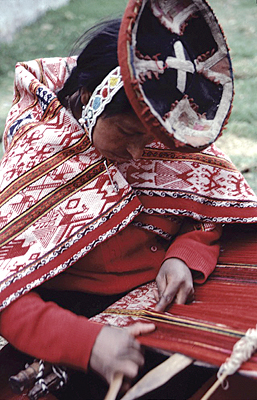Preface for Master Weavers of the Altiplano
By Gerhardt Knodel,
Artist and Director Emeritus of the Cranbrook Academy of Art, Bloomfield Hills, Michigan
 Warp faced patterns have been crafted by female master weavers in the same manner for 2000 years
Warp faced patterns have been crafted by female master weavers in the same manner for 2000 years
An extraordinary aspect of great art is that it reveals truths that seem to be self-evident. Embedded within some manmade objects are characteristics best described as natural or essential, unassailable authentic expressions of the very essence of life. Our fascination with those objects is rooted in the mystery of their making and our inability to fully comprehend the sources of inspiration that led individuals to transform commonplace materials into visual works that live with us in important ways.
As a weaver fascinated by the miraculous transitions possible by spinning then weaving fine fibers into pliable planes of functional fabric, I see these textiles as nothing less than spectacular! But like beautiful poetry or literature or music, they are not the products of momentary innovation, or of “bright ideas,” but they convey a sense of deep roots in long histories of development, and a sense of belonging and importance in the material environment of the people who made them.
Most artists consider the work they produce to be a medium of communication. Heart, soul and intelligence are projected into the experience of art making, and the products offer a kind of meeting ground wherein the focus of the maker comes together with the attention of the viewer, and something new is created. Imagine how exciting it was to discover a group of textiles in Bradley’s collection that are physically used as platforms for exchange in negotiations between individuals. The squares of beautifully patterned fabric become a place, like a game board, for important transactions to occur.
The textile is essential in setting the stage for the transaction, and it survives for generations as evidence and memory of the event. In understanding the degree of importance brought to the textile by the culture in which it originates, the broad range of textiles in the Cross collection may be considered as vital extensions of life experiences. In other words, as “Art.”
While there is significant pleasure derived from information about these textiles, their essence is found in the visual and tactile relationships they offer. In the hands of skilled weavers, colored stripes become a rich vocabulary offering endless variation best thought of in relation to improvisational jazz. Performance is never repetitive.
The fibers of which textiles are made are thirsty. They vigorously absorb an enormous spectrum of color exclusively derived in earlier times from natural
sources. Combined with the natural range and subtle variations of blacks, browns, greys and whites of the animal fibers from which thread is spun, a broad color palate, reflective of the weaver’s locale, offers the weaver a magnificent resource for invention.
In the hands of a skillful weaver, the textile becomes a field for visual invention not so dissimilar to the relationship of an artist working with pencil on paper or paint on canvas. The major difference is that textiles are built line by line in a progression that does not allow erasure. Textile imagery is not on the surface of cloth, but is imbedded in it. Subjects live in the space of woven threads.
This publication provides an opportunity to participate in the personal stories and life of these textiles.